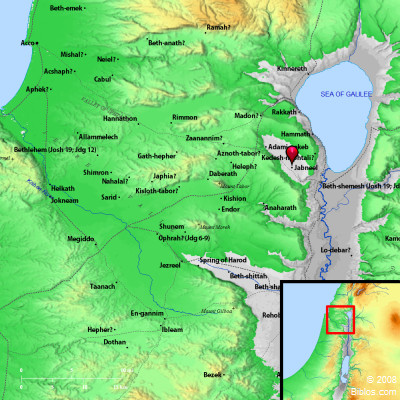Encyclopedia
JABNEEL; JABNEHjab'-ne-el, jab'-ne (yabhne'el, "God is builder"; Septuagint Lebna, Swete reads Lemna; the Apocrypha has Iamnia, Iamneia):
(1) A town on the northern border of the land assigned to Judah, near the western sea, mentioned in connection with Ekron (Joshua 15:11). The place is now represented by the modern village of Yebna which stands upon a hill a little to the South of the Nahr Rubin, about 12 or 13 miles South of Jaffa, on the road from there to Askelon, and about 4 miles from the sea. It had a port, now called Mina Rubin, a short distance South of the mouth of the river, some remains of which still exist. Its harbor was superior to that of Jaffa (PEFS, 1875, 167-68). It does not occur in the Hebrew text of the Old Testament except in the passage mentioned, but it appears under the form "Jabneh" (yabhneh) in 2 Chronicles 26:6, as is evident from the mention of Gath and Ashdod in connection with it. The Septuagint reads Gemna (Jabneh) where the Hebrew reads wa-yammah, "even unto the sea," in Joshua 15:46, where Ekron and Ashdod and other cities and villages are mentioned as belonging to Judah's inheritance. Josephus (Ant., V, i, 22) assigns it to the tribe of Dan. We have no mention of its being captured by Joshua or occupied by Judah until the reign of Uzziah who captured it and demolished its wall, in connection with his war upon the Philistines (2 Chronicles 26:6). The position of Jabneel was strong and was the scene of many contests, both in the period of the monarchy and that of the Maccabees. It is mentioned frequently in the account of the wars of the latter with the Syrians. It was garrisoned by the Seleucid kings, and served as a base for raiding the territory of Judah. When Judas Maccabeus defeated Gorgias and the Syrians he pursued them to the plains of Jabneel, but did not take the fortress (1 Maccabees 4:15). Gorgias was there attacked by the Jewish generals Joseph and Azarias, contrary to Judas' orders, who were repulsed with loss (1 Maccabees 5:56-60; Josephus, Ant, XII, viii, 6). Apollonius occupied it for King Demetrius (1 Maccabees 10:69); and Cendebeus for Antiochus, and from there harassed the Jews (1 Maccabees 15:40). Judas burned the port and navy of Jabneel (2 Maccabees 12:8-9). It was taken by Simon in 142 B.C. (Josephus, Ant, XIII, vi, 7; BJ, I, ii, 2), together with Gazara and Joppa, but was restored to its inhabitants by Pompey in 62 B.C. (Ant., XIV, iv, 4), and was rebuilt by Gabinius in 57 B.C. (BJ, I, viii, 4). It was restored to the Jews by Augustus in 30 A.D. Herod gave it to his sister Salome and she bequeathed it to Julia, the wife of Augustus (Ant., XVIII, ii, 2; BJ, II, ix, 1). The town and region were prosperous in Roman times, and when Jerusalem was besieged by Titus the Sanhedrin removed to Jabneel, and it afterward became the seat of a great rabbinical school (Milman, History of the Jews, II, 411-12), but was suppressed in the persecution under Hadrian. Antonius allowed it to be revived, but it was again suppressed because of hostile language on the part of the rabbis (ibid., 451-52). The Crusaders built there the castle of Ibelin, supposing it to be the site of Gath. It was occupied by the Saracens, and various inscriptions in Arabic of the 13th and 14th centuries have been found there (SWP, II, 441-42).
(2) A town of Naphtali mentioned in Joshua 19:33, and supposed to be the site of the modern Yemma, Southwest of the sea of Galilee (SWP, I, 365). It is the Kefr Yama of the Talmud
H. Porter




